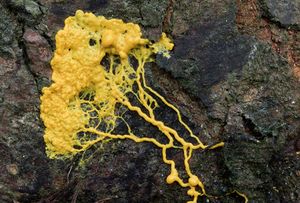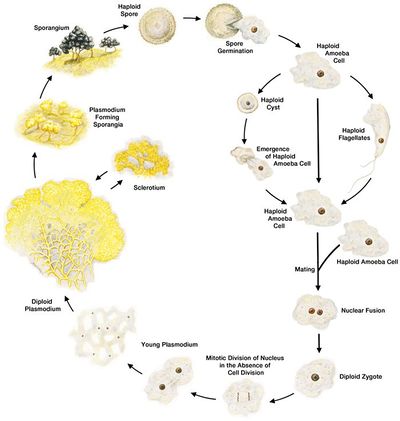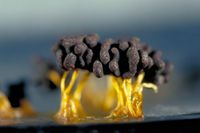Physarum polycephalum: Difference between revisions
No edit summary |
|||
| Line 17: | Line 17: | ||
In unfavorable conditions and in the absence of light, the plasmodium will revert into a temporary and reversible dormant state known as a sclerotium. Many nuclei in the starved plasmodium will degenerate, but those that persist will undergo mitotic division at a slowed rate. <ref name = Guttes/> In this form, they are dry and hardened until favorable conditions return. | In unfavorable conditions and in the absence of light, the plasmodium will revert into a temporary and reversible dormant state known as a sclerotium. Many nuclei in the starved plasmodium will degenerate, but those that persist will undergo mitotic division at a slowed rate. <ref name = Guttes/> In this form, they are dry and hardened until favorable conditions return. | ||
<br><br> | <br><br> | ||
[[Image:sporulation.jpg|thumb|200px|right|Sporangium of <i>P. physarum</i>.[https://www.google.com/url?sa=i&url=https%3A%2F%2Fwww.carolina.com%2Fteacher-resources%2FInteractive%2Fthink-single-celled-organisms-are-simple-think-again-the-slime-mold-physarum-polycephalum-a-single-celled-organism-for-student-investigations%2Ftr41405.tr&psig=AOvVaw38Cv_99KJZdgmGguK-8w4L&ust=1607643911774000&source=images&cd=vfe&ved=0CAIQjRxqFwoTCJDY8LSKwu0CFQAAAAAdAAAAABBS].]] | |||
<b>Sporulation</b> | <b>Sporulation</b> | ||
<br> | <br> | ||
Revision as of 23:49, 9 December 2020
Introduction

Physarum polycephalum is a species of acellular slime molds, or Myxomycetes. Despite having a similar name to fungi, these organisms are protists. They are most commonly found in soil, moist vegetation, and the forest floor where it is cool, damp, and dark, where they contribute to the decomposition of dead vegetation. P. polycephalum have very diverse forms of life in a single cycle, as they can range from being a microscopic single-celled amoeba, a multinucleated cell, or plasmodium, that can span several feet, morphing into a hardened mass known as a sclerotium, or forming small, delicate fruiting bodies that produce haploid spores.
Due to its unique life cycle and large plasmodium stage, P. polycephalum is used as a model organism for the studies of cell cycle regulation, cell differentiation, and cellular motility. A multitude of studies have been done on this species of slime mold in order to research and comprehend its methods of communication and apparent intelligence. It is currently unknown as to what the molecular and genetic properties of this organism are that make it capable of having awareness and decision making, as further studies are currently in the process of obtaining conclusive results.
Life Cycle

P. Polycephalum undergoes many changes during its life. The formation of its cycles is dependent upon environmental stressors and the presence or absence of other Physarum{3}
Plasmodium
The most commonly observed form of the Physarum polycephalum is its plasmodial form. The plasmodium is a large, singular cell with multiple diploid nuclei, each nuclei which undergo synchronous mitotic divisions, and the absence of cytokines.[1] These single cells can grow to a diameter of over a foot long as they continue to consume bacteria, fungal spores, and dead organic matter in its wild environment. When in nutrient-rich agar or other liquid cultures, plasmodium cells will readily grow axenically, no longer needing to engulf microbes to aid in the decomposition of organic matter.
Sclerotium
In unfavorable conditions and in the absence of light, the plasmodium will revert into a temporary and reversible dormant state known as a sclerotium. Many nuclei in the starved plasmodium will degenerate, but those that persist will undergo mitotic division at a slowed rate. [1] In this form, they are dry and hardened until favorable conditions return.

Sporulation
If a starving plasmodium is in the presence of light, it will differentiate into sporangia; clusters of spores atop the tips of stalks. In its natural environment, this would be when the Physarum emerges from under organic matter such as leaf litter on the forest floor.[2][3] The organism can survive for much longer in this formation, because of the spores' higher resistance to environmental stress because of its layered cell wall. Many types of organisms across the tree of life undergo sporulation, especially plants and fungi. The spores of many Myxomycetes, such as P. polycephalum, have smooth spore walls covered with protectives spikes.[4] Unlike the dormant state of the sclerotium, sporangia is an irreversible pathway that the plasmodium transitions into. Haploid spores are created by the process of meiosis during sporulation, these spores remain dormant until agitated and in the recurrence of favorable conditions. The haploid spores will break away from the tip of the stalk and, upon germination with sufficient moisture, develop into haploid amoeba cells.
Amoeba
The germination of haploid spores gives rise to uninucleate amoeba cells.
Behavioral Characteristics
Optimal Foraging
Cytoplasmic Streaming
Conclusion
Physarum polycephalum appear to exhibit communication and intelligence, unlike most organisms.
References
- ↑ 1.0 1.1 Guttes, E., Guttes, S., & Rusch, H. P. (1961). Morphological observations on growth and differentiation of Physarum polycephalum grown in pure culture. Developmental Biology, 3(5), 588-614. doi:10.1016/0012-1606(61)90034-3
- ↑ Think Single-Celled Organisms Are Simple? Think Again! The Slime Mold Physarum polycephalum, a Single-Celled Organism for Student Investigations. (n.d.). Retrieved December 05, 2020, from https://www.carolina.com/teacher-resources/Interactive/think-single-celled-organisms-are-simple-think-again-the-slime-mold-physarum-polycephalum-a-single-celled-organism-for-student-investigations/tr41405.tr
- ↑ Introduction to the "Slime Molds". (n.d.). Retrieved December 05, 2020, from https://ucmp.berkeley.edu/protista/slimemolds.html
- ↑ Alexopoulos, C. J. (1963). The Myxomycetes II. The Botanical Review, 29(1), 1-78. doi:10.1007/bf02860818
Edited by Freya Beinart, student of Joan Slonczewski for BIOL 116 Information in Living Systems, 2020, Kenyon College.
